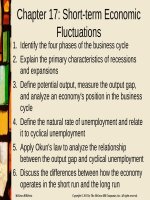Lecture Principles of financial accouting - Chapter 17: Analysis of financial statements
Bạn đang xem bản rút gọn của tài liệu. Xem và tải ngay bản đầy đủ của tài liệu tại đây (1.84 MB, 43 trang )
Chapter 17
ANALYSIS OF FINANCIAL
STATEMENTS
PowerPoint Authors:
Susan Coomer Galbreath, Ph.D., CPA
Charles W. Caldwell, D.B.A., CMA
Jon A. Booker, Ph.D., CPA, CIA
Cynthia J. Rooney, Ph.D., CPA
Winston Kwok, Ph.D., CPA
McGrawHill/Irwin
Copyright © 2011 by The McGrawHill Companies, Inc. All rights reserved.
17 2
C 1
BASICS OF ANALYSIS
Reduces
Reduces
uncertainty
uncertainty
Application
Application
of
of analytical
analytical
tools
tools
Involves
Involves
transforming
transforming
data
data
Financial
Financial statement
statement analysis
analysis helps
helps users
users
make
make better
better decisions.
decisions.
Internal Users
Managers
Officers
Internal Auditors
External Users
Shareholders
Lenders
Customers
17 3
C 1
BUILDING BLOCKS OF ANALYSIS
Liquidity and
efficiency
Solvency
Profitability
Market
prospects
17 4
C 1
INFORMATION FOR ANALYSIS
1. Income Statement (Statement of
Comprehensive Income)
2. Balance Sheet (Statement of
Financial Position)
3. Statement of Changes in Equity
4. Statement of Cash Flows
5. Notes to the Financial Statements
17 5
C 1
STANDARDS FOR COMPARISON
When we interpret our analysis, it is essential to
compare the results we obtained to other
standards or benchmarks.
Intracompany
Competitors
Industry
Guidelines
17 6
C 2
TOOLS OF ANALYSIS
Horizontal Analysis
Comparing a company’s financial condition and
performance across time.
Vertical Analysis
Comparing a company’s financial condition and
performance to a base amount.
Ratio Analysis
Measurement of key relations between financial statement
items.
17 7
P 1
HORIZONTAL ANALYSIS
17 8
P 1
COMPARATIVE STATEMENTS
Calculate Change in Dollar Amount
Dollar
Change
=
Analysis Period
Amount
–
Base Period
Amount
When measuring
measuring the
the amount
amount of the
the
change in dollar amounts, compare the
analysis period
period balance to the base
period balance. The analysis period is
usually the current year while the base
period is
is usually the
the prior year.
17 9
P 1
COMPARATIVE STATEMENTS
Calculate Change as a Percent
Percent
Change
=
Dollar Change
Base Period Amount
When calculating the change as a
percentage, divide the amount of the
dollar change by the base period
amount, and then multiply by 100 to
convert
convert to a percentage.
×
100
17 10
P 1
HORIZONTAL ANALYSIS
$1,550,861
$1,550,861 –– $835,546
$835,546 == $715,315
$715,315
($715,315 ÷ $835,546) × 100 = 85.6%
17 11
P 1
HORIZONTAL ANALYSIS
$14,953,224
$14,953,224 –– $11,065,186
$11,065,186 == $3,888,038
$3,888,038
($3,888,038 ÷ $11,065,186) × 100 = 35.1%
17 12
P 1
TREND ANALYSIS
Trend analysis is used to reveal patterns in data
covering successive periods.
Trend
Percent
=
Analysis Period Amount
Base Period Amount
×
100
17 13
P 1
TREND ANALYSIS
Research in Motion
Income Statement Information
Using 2006 as the base year we will get the following trend information :
Examples
Examples of
of 2006-2008
2006-2008 Calculations
Calculations for
for Revenues:
Revenues:
2006
2006 is
is base
base year.
year. Set
Set to
to 100%
100%
2007:
2007: $3,037,103
$3,037,103 ÷÷ $2,065,845
$2,065,845 ×× 100
100 == 147.0%
147.0%
2008:
2008: $6,009,395
$6,009,395 ÷÷ $2,065,845
$2,065,845 ×× 100
100 == 290.9%
290.9%
17 14
P 1
TREND ANALYSIS
We can use the trend percentages to construct a
graph so we can see the trend over time.
17 15
P 2
VERTICAL ANALYSIS
Common-Size Statements
Common-size
Percent
=
Analysis Amount
Base Amount
×
100
Financial Statement
Base Amount
Balance Sheet
Total Assets
Income Statement
Revenues
17 16
P 2
COMMON-SIZE BALANCE SHEET
($1,550,861
($1,550,861 ÷÷ $10,204,409)
$10,204,409) ×× 100
100 == 15.2%
15.2%
($835,546
($835,546 ÷÷ $8,101,372)
$8,101,372) ×× 100
100 == 10.3%
10.3%
17 17
P 2
COMMON-SIZE INCOME STATEMENT
($8,368,958
($8,368,958 ÷÷ $14,953,224)
$14,953,224) ×× 100
100 == 56.0%
56.0%
17 18
P 2
COMMON-SIZE GRAPHICS
17 19
P 3
RATIO ANALYSIS
Liquidity
and
efficiency
Solvency
Profitability
Market
prospects
17 20
P 3
LIQUIDITY AND EFFICIENCY
Current
Current
Ratio
Ratio
Inventory
Inventory
Turnover
Turnover
Acid-test
Acid-test
Ratio
Ratio
Accounts
Accounts
Receivable
Receivable
Turnover
Turnover
Days
Days’’ Sales
Sales
Uncollected
Uncollected
Days
Days’’
Purchases
Purchases in
in
Accounts
Accounts
Payable
Payable
Total
Total Asset
Asset
Turnover
Turnover
Days
Days’’ Sales
Sales
in
in Inventory
Inventory
17 21
P 3
WORKING CAPITAL
Working capital represents current assets
financed from long-term capital sources that
do not require near-term repayment.
Current assets
– Current liabilities
= Working capital
More
More working
working capital
capital suggests
suggests aa strong
strong liquidity
liquidity
position
position and
and an
an ability
ability to
to meet
meet current
current obligations.
obligations.
17 22
P 3
CURRENT RATIO
Current Assets
Current Ratio =
Current Liabilities
This
This ratio
ratio measures
measures the
the short-term
short-term debtdebtpaying
paying ability
ability of
of the
the company.
company. A
A higher
higher
current
current ratio
ratio suggests
suggests aa strong
strong liquidity
liquidity
position.
position.
17 23
P 3
ACID-TEST RATIO
Acid-test ratio =
Cash + Short-term investments + Current
receivables
Current Liabilities
Referred
Referred to
to as
as Quick
Quick Assets
Assets
This
This ratio
ratio is
is like
like the
the current
current ratio
ratio but
but excludes
excludes current
current assets
assets
such
such as
as inventories
inventories and
and prepaid
prepaid expenses
expenses that
that may
may be
be
difficult
difficult to
to quickly
quickly convert
convert into
into cash.
cash.
17 24
P 3
ACCOUNTS RECEIVABLE TURNOVER
Accounts receivable
turnover
Average accounts receivable =
=
Net sales
Average accounts receivable,
net
(Beginning acct. rec. + Ending acct. rec.)
2
This
This ratio
ratio measures
measures how
how
many
many times
times aa company
company
converts
converts its
its receivables
receivables
into
into cash
cash each
each year.
year.
17 25
P 3
INVENTORY TURNOVER
Inventory turnover =
Average inventory =
Cost of goods sold
Average inventory
(Beginning inventory + Ending inventory)
2
This
This ratio
ratio measures
measures the
the
number
number of
of times
times
merchandise
merchandise is
is sold
sold and
and
replaced
replaced during
during the
the year.
year.









